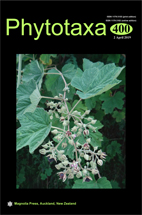Abstract
Three taxa of Scapania with Sino-Himalayan and meta-Himalayan distribution are described as new to science: S. pseudojavanica from the southern portion of the eastern spur of the Tibetan Plateau in southern China and North Vietnam, S. metahimalayana with a disjunct distribution that ranges from Nepal (where its distribution is questionable) to North Vietnam, and S. sichuanica from high elevation in Sichuan in SW China. Each species is morphologically similar to taxa distributed in the more humid and warmer climates of East and South-East amphi-oceanic Asia. The differentiation is presumably the result of recent speciation in the Sino-Himalayas and adjacent lands and the observed differentiation and distribution patterns are in support of the geographic approach in splitting hepatic species. The initial differentiation of these Scapania in sect. Stephania was the specialization into two groups: with brown and colorless gemmae, both being predominantly unicellular.

